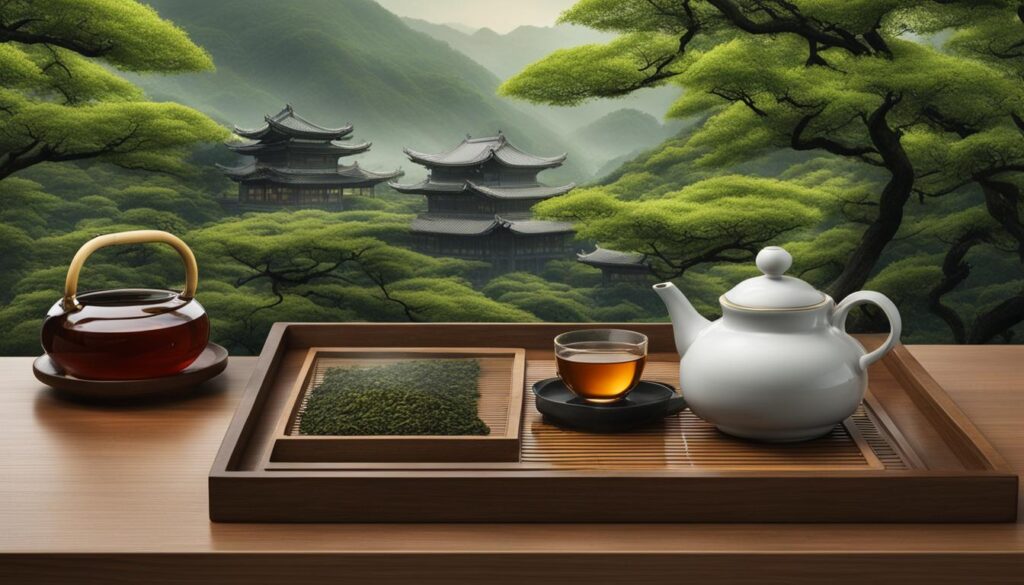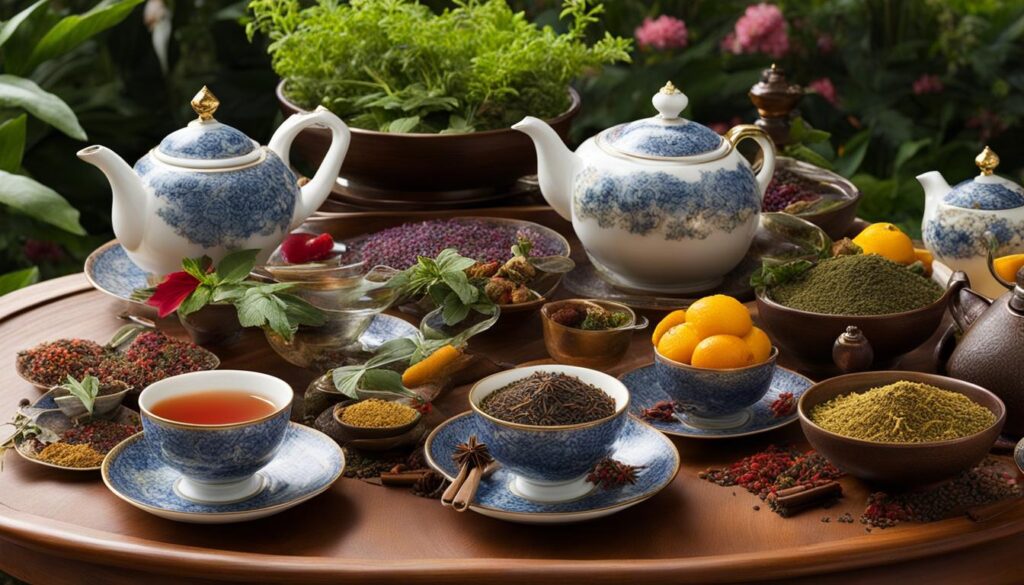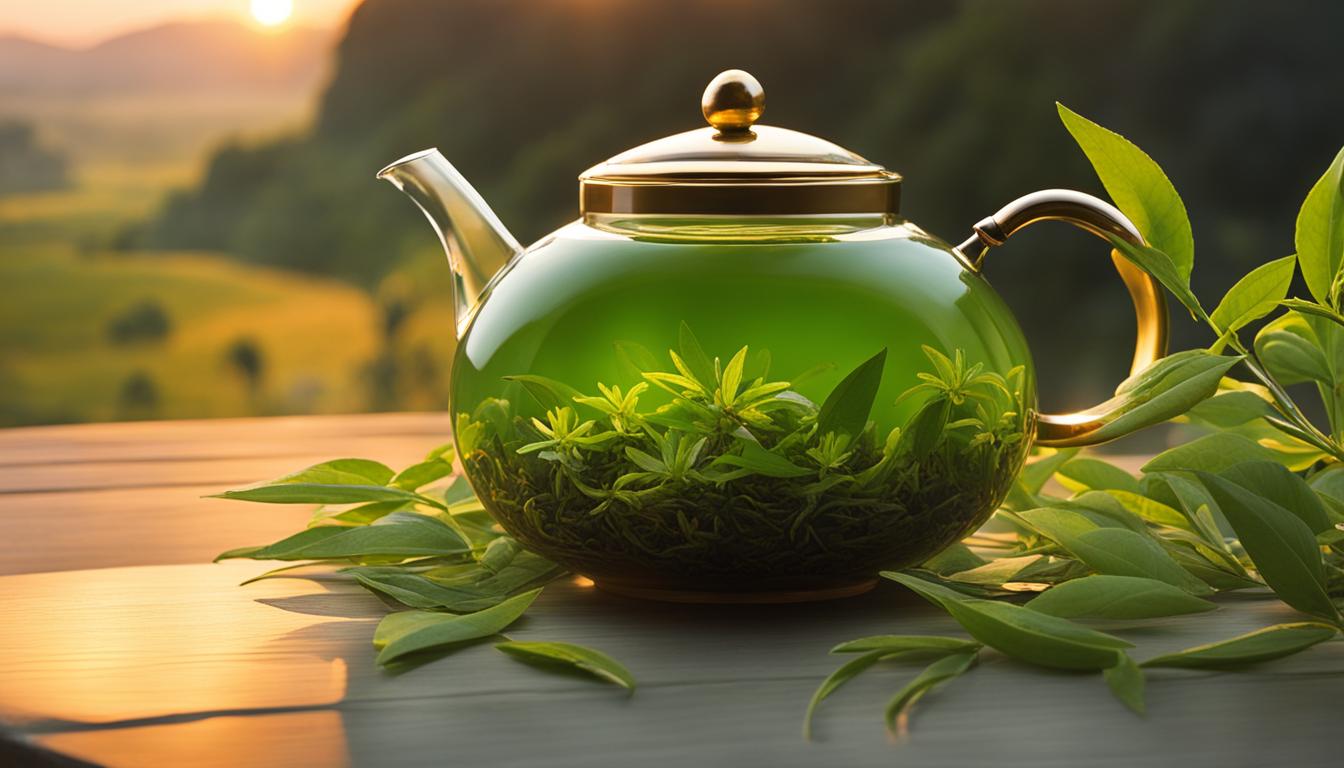Welcome to our journey into the world of rare and exotic teas from global regions! Tea, with its rich history and diverse flavors, has enchanted people around the globe for centuries. From remote corners of the world, we bring you a tantalizing glimpse into the unique tea discoveries that await your taste buds.
Each global region boasts its own exquisite tea traditions, offering a captivating blend of culture, heritage, and flavors. From the lush tea gardens of China to the remote plantations of India, and the ceremonial matcha rituals in Japan to the delicate sencha teas, there’s a whole world of tea waiting to be explored.
So join us on this adventure as we delve into the origins and history of tea, uncover regional tea varieties and flavors, hunt for rare tea finds, embark on exotic tea tasting adventures, and discover the culinary delights that these precious teas have to offer.
Key Takeaways:
- Rare and exotic teas from global regions offer a fascinating glimpse into different cultures and flavor profiles.
- Tea has a rich history and has played significant roles in various societies, from its origins in ancient China to becoming a universal beverage.
- Each global region has its own unique tea varieties and flavors, such as China’s green, black, oolong, and white teas, India’s robust Assam and Darjeeling black teas, and Japan’s ceremonial matcha and sencha teas.
- Hunting for rare tea finds in remote and isolated regions can lead to the discovery of exceptional tea gems that are not widely available.
- Embarking on exotic tea tasting adventures allows you to expand your palate and experience the intricate flavors and aromas of lesser-known teas.
The Origins and History of Tea
Tea, a beloved beverage enjoyed by countless people worldwide, has a fascinating history that dates back centuries. Its origins can be traced to ancient China, where it was first discovered around 2737 B.C. According to legend, Emperor Shen Nung accidentally stumbled upon tea when a tea leaf fell into his cup of hot water, creating a refreshing and enjoyable drink. From this serendipitous encounter, tea cultivation and consumption spread throughout China, eventually reaching far corners of the globe.
Tea’s history in China is intertwined with its cultural significance. It was not just a beverage; it became a symbol of social rituals and ceremonies, valued for its medicinal properties and enjoyed by emperors and commoners alike. As tea reached other parts of the world, it took on new meanings and adaptations. It became a universal beverage that transcended borders and connected people from different cultures. Today, tea remains an integral part of everyday life and is celebrated for its diversity and versatility.
“Tea, the taste of life.” – Anonymous
Tea’s journey from China to the rest of the world sparked a global fascination with this remarkable plant. Each region that embraced tea infused its own unique flavors, traditions, and brewing methods. From the delicate green teas of Japan to the robust black teas of India, the world of tea is a treasure trove of diverse and exquisite flavors. Exploring the origins and history of tea allows us to appreciate the rich tapestry of cultures and traditions that have shaped this beloved beverage.
Tea’s Global Influence
The global influence of tea can be seen in the numerous tea cultures and customs that exist today. In China, tea is an integral part of daily life and is steeped in profound symbolism. In Japan, the art of tea ceremony embodies grace, harmony, and attention to detail. In India, tea is a national obsession, with chai being a staple in households and street corners. The British afternoon tea is a testament to the enduring love for tea in the Western world. Tea has truly transcended boundaries and become a universal language, connecting people from all walks of life.
Summing it up
The origins and history of tea are a testament to its enduring appeal and cultural significance. From its humble beginnings in ancient China to its global presence today, tea has captivated hearts and palates around the world. It has evolved and adapted, yet its essence remains constant—a beverage that brings people together, offers moments of solace, and celebrates the beauty of nature. So, let us raise our teacups and toast to the rich history and timeless allure of tea!
Regional Tea Varieties and Flavors
When it comes to rare and exotic teas, each global region has its own unique offerings that tantalize the taste buds and provide a glimpse into the rich tea traditions around the world. Let’s dive into the distinct varieties and flavors from China, India, and Japan, where tea is deeply ingrained in the culture.
The Diverse World of Chinese Teas
China is renowned for its diverse tea repertoire, ranging from delicate white teas to rich black teas. Chinese tea varieties are known for their complex flavor profiles and ancient origins. Some popular Chinese teas include:
- Green tea: Known for its refreshing taste and numerous health benefits, Chinese green teas like Dragon Well (Longjing) and Biluochun are highly prized.
- Black tea: China produces several black tea varieties, such as Keemun and Lapsang Souchong, which offer robust flavors with hints of smoke and malt.
- Oolong tea: Oolong teas, such as Tie Guan Yin and Da Hong Pao, strike a balance between the freshness of green tea and the richness of black tea, resulting in complex and aromatic brews.
- White tea: White teas like Silver Needle and White Peony are known for their delicate flavors and subtle floral notes, often regarded as some of the rarest and most prized teas in the world.
Exploring Indian Tea Traditions
India, with its extensive tea plantations, boasts an array of teas that cater to different palates. From strong and malty Assam teas to fragrant and muscatel Darjeeling teas, there’s something for everyone. Here are some iconic Indian teas:
- Assam tea: Grown in the lush valleys of Assam, this tea has a bold and robust flavor, making it ideal for those who prefer a strong cup.
- Darjeeling tea: Known as the “Champagne of Teas,” Darjeeling teas are highly sought after for their floral aroma, muscatel flavor, and light-bodied nature.
- Nilgiri tea: Grown in the picturesque Nilgiri mountains of southern India, Nilgiri teas are known for their smooth and mellow taste with fruity undertones.
- Masala chai: A staple in Indian households, masala chai is a spiced tea made with black tea leaves, milk, and a blend of aromatic spices like cardamom, cinnamon, and cloves.
The Elegance of Japanese Tea Culture
Japan has a long and storied tea tradition, with a focus on ceremonial practices and the pursuit of perfection. Japanese teas are prized for their vibrant green color, umami flavor, and meticulous preparation. Here are some quintessential Japanese teas:
- Matcha: A powdered green tea used in traditional tea ceremonies, matcha is known for its vibrant green color, creamy texture, and earthy flavor.
- Sencha: The most commonly consumed tea in Japan, sencha offers a crisp and refreshing taste with grassy notes, making it perfect for everyday enjoyment.
- Gyokuro: Considered one of the highest grades of Japanese tea, gyokuro is shaded for several weeks before harvest, resulting in a rich, sweet flavor and a distinct umami taste.
- Hojicha: Hojicha is a roasted green tea with a golden-brown color and a toasty, nutty flavor, making it a popular choice for those seeking a milder tea experience.

Rare Tea Finds: Exploring Exclusive Teas from Isolated Regions
When it comes to the world of tea, there is a hidden treasure waiting to be discovered in the form of rare and exclusive teas from isolated regions. These teas, often produced in remote areas of Asia, offer a unique and exceptional experience that cannot be found elsewhere. From the misty mountains of China to the tea gardens of Sri Lanka, these teas are a testament to the skill and craftsmanship of local tea growers.
One of the most intriguing aspects of rare tea finds is the sense of adventure and exploration that comes with searching for these hidden gems. It’s like embarking on a tea treasure hunt, where every cup holds the promise of uncovering a new and exciting flavor profile. Each sip takes you on a journey through the terroir and culture of the region, allowing you to connect with the people and places behind the tea.
What makes these exclusive teas truly special is their limited availability. Due to their production in small quantities and the remote nature of their sourcing, they are often not widely accessible. This scarcity adds to their allure and makes them highly sought after by tea connoisseurs and enthusiasts alike. If you are lucky enough to get your hands on a rare tea find, it’s an experience that is sure to leave a lasting impression.
To fully appreciate the uniqueness of these teas, it’s important to approach them with an open mind and a sense of curiosity. Embrace the opportunity to explore new flavors and aromas, and let your taste buds guide you on a journey of discovery. Whether it’s a rare white tea from the mountains of Nepal or an exclusive oolong from Taiwan, each cup of tea is a chance to immerse yourself in the rich and diverse world of rare tea finds.
Exotic Tea Tasting Adventures
Embark on an exhilarating journey of exotic tea tasting adventures as we explore the hidden treasures of global markets and discover the world of little-known teas. From bustling tea auctions to remote tea plantations, there are endless opportunities to immerse yourself in the rich and diverse flavors of rare teas from around the world. Whether you’re a seasoned tea connoisseur or a curious tea enthusiast, these tasting adventures will take your tea experience to new heights.
Step into the lively atmosphere of global markets, where the air is filled with the aroma of exotic teas and the excitement of rare tea finds. Explore the bustling streets and alleys, browsing through stalls adorned with colorful tea leaves and ornate teaware. Engage with local tea merchants, who will share their expertise and guide you through a vast selection of teas, each with its own unique story and flavor profile. From the vibrant markets of India to the intimate tea houses of Japan, these global marketplaces offer a treasure trove of rare and extraordinary teas waiting to be discovered.
For the true adventurers at heart, embark on a journey to remote and lesser-known tea regions, where rare tea gems are cultivated with love and care. Visit the misty mountains of Nepal, where towering tea gardens produce exquisite teas that are rich in flavor and aroma. Journey to the enchanting hills of Sri Lanka, where the cool climate and fertile soil create the perfect conditions for exceptional tea varieties. Explore the serene landscapes of Taiwan, where tea artisans meticulously craft unique oolongs that captivate the senses. These tea hunting expeditions will not only satisfy your thirst for rare finds but also provide an opportunity to connect with the tea-growing communities and gain a deeper understanding of their craft.
As you embark on these exotic tea tasting adventures, be prepared to indulge in a world of flavors that will captivate your taste buds and transport you to distant lands. Savor the delicate floral notes of a rare white tea, or revel in the bold and robust profile of a rare pu-erh tea. Discover the subtle nuances of unique tea varieties, each with its own distinct character and story. Expand your tea journey and immerse yourself in the rich tapestry of global tea traditions, where every sip unveils a new and exciting adventure.

Table: Exotic Tea Tasting Adventures
| Destination | Highlights |
|---|---|
| India | Explore the bustling tea markets of Darjeeling and Assam, and taste the robust flavors of Indian black teas |
| Japan | Participate in a traditional tea ceremony and experience the serene ambiance of Japanese tea houses |
| Nepal | Visit the remote tea gardens nestled in the Himalayas and sample the delicate flavors of Nepalese teas |
| Sri Lanka | Immerse yourself in the scenic landscapes of the tea-growing regions and taste the exquisite Ceylon teas |
| Taiwan | Explore the tea plantations and learn from tea artisans about the intricate process of crafting unique oolong teas |
The Culinary Delights of Rare Exotic Teas
Rare and exotic teas are not only a delight to drink but also a culinary delight. Their distinct flavors and aromatic profiles can be used to create unique culinary experiences. From using matcha powder in desserts to infusing teas into savory dishes, the versatility of rare teas opens up a world of culinary possibilities. Whether you’re a tea connoisseur or a food enthusiast, exploring the culinary delights of rare exotic teas can add a new dimension to your gastronomic adventures.
Imagine savoring a delicate Darjeeling-infused chocolate truffle or enjoying a refreshing Earl Grey-infused salad dressing. The intricate flavors and aromatic notes of rare teas can enhance both sweet and savory dishes, elevating them to new levels of culinary excellence. It’s an opportunity to experiment with different tea varieties and discover unexpected flavor combinations that will tantalize your taste buds.
To showcase the culinary potential of rare exotic teas, we’ve prepared a table that highlights some exquisite tea varieties and their recommended culinary pairings. This table provides a handy guide for connoisseurs looking to explore the world of tea-infused cuisine. From delicate floral teas like Jasmine to smoky and earthy teas like Lapsang Souchong, each tea offers a unique flavor profile that can enhance a wide range of dishes.
Table: Rare Exotic Tea Varieties and Their Culinary Pairings
| Tea Variety | Culinary Pairings |
|---|---|
| Matcha | Mochi, Green Tea Ice Cream, Smoothies |
| Oolong | Roasted Duck, Stir-Fried Vegetables, Pineapple Cake |
| Earl Grey | Shortbread Cookies, Lemon Curd, Lavender-infused Drinks |
| Jasmine | Steamed Fish, Jasmine Rice, Jasmine Tea Sorbet |
| Lapsang Souchong | Smoked Meat, Dark Chocolate, Barbecue Sauce |
As you embark on your culinary journey with rare exotic teas, don’t be afraid to get creative. Experiment with different cooking techniques and ingredients to bring out the best of each tea’s unique flavors. Whether you’re hosting a dinner party or simply indulging in your own gastronomic adventures, incorporating rare teas into your culinary repertoire will impress your guests and leave them craving more.
Conclusion
As we conclude our journey into the rare and exotic tea world, we can’t help but reflect on the incredible discoveries we’ve made along the way. From the lush tea plantations of Asia to the remote regions of the world, we’ve uncovered rare tea gems that have captivated our senses and expanded our tea horizons.
Exploring the diverse flavors and aromas of these teas has been a truly enriching experience. Each cup has transported us to a different culture, allowing us to appreciate the traditions and history associated with tea. From the delicate notes of a Chinese white tea to the robust flavors of an Indian Assam black tea, our palates have been treated to a delightful array of taste sensations.
But our journey doesn’t end here. The world of rare tea discoveries is vast and ever-evolving. There are still so many untapped treasures waiting to be found. So, let’s continue our exploration, one sip at a time, and uncover the hidden wonders that the exotic tea world has to offer. Cheers to rare tea discoveries!
FAQ
What is the history of tea?
Tea has a rich history that dates back to ancient China, where it was first discovered around 2737 B.C. According to legend, Emperor Shen Nung accidentally discovered tea when a tea leaf fell into his cup of hot water. From there, tea cultivation and consumption spread throughout China and eventually reached other parts of the world.
What types of teas can be found in different regions?
Each global region that produces tea has its own unique varieties and flavors. For example, China offers green, black, oolong, and white teas, each with its own distinct characteristics. India is known for its robust black teas like Assam and Darjeeling, while Japan is famous for ceremonial matcha green tea and delicate sencha tea.
Where can I find rare tea finds?
Asia, in particular, is home to many remote and isolated regions where unique tea varieties are grown. From the high mountains of Nepal to the hills of Sri Lanka, these regions produce teas that are highly sought-after for their exceptional quality and flavor profiles.
How can I embark on exotic tea tasting adventures?
There are endless opportunities to sample and experience rare and little-known teas. You can attend tea auctions in global markets, visit tea plantations in remote regions, or explore tea shops that specialize in unique tea varieties.
Can rare and exotic teas be used in cooking?
Absolutely! The distinct flavors and aromatic profiles of rare teas can be used to create unique culinary experiences. From using matcha powder in desserts to infusing teas into savory dishes, the versatility of rare teas opens up a world of culinary possibilities.
How can exploring rare and exotic teas enrich my tea experience?
Exploring the world of rare and exotic teas allows you to learn about different cultures, taste unique flavors, and appreciate the rich history and traditions associated with tea. It deepens your appreciation for the diverse and fascinating world of tea.





